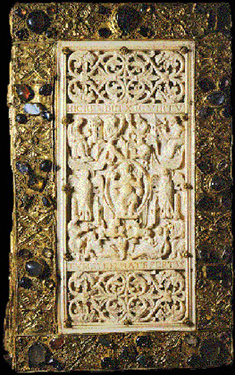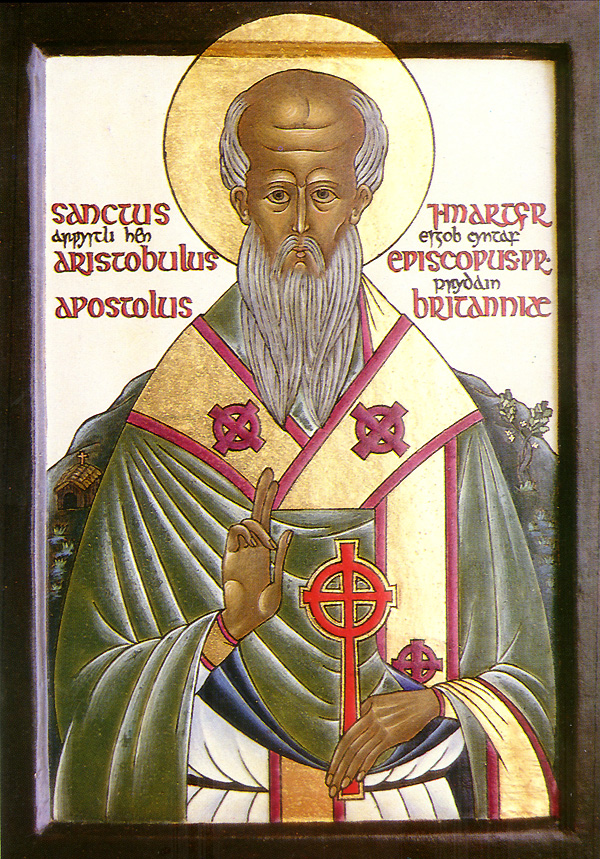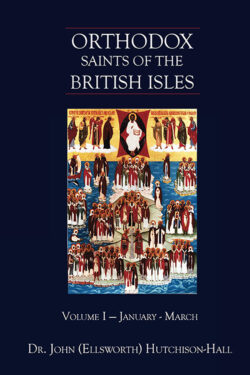
Orthodox Saints of the Pre-Schism
See of Rome
28th March (NS) — 15th March (OS) 2024
ARISTOBULUS of the SEVENTY, (First Century), the Holy Apostle Aristobulus of the Seventy, Bishop of Britain is traditionally numbered as one of the Seventy Apostles, and is the Aristobulus mentioned by St. Paul (29th June) in his epistle to the Romans (16:10). According to tradition, St. Aristobulus was consecrated bishop by St. Paul and sent to Britain where he worked to enlighten the pagan population and ultimately met his martyrdom.
LEOCRITIA (LUCRETIA), raised as a Muslim in a wealthy Moorish family, St. Leocritia converted to Christianity. Upon learning of her conversion, her family banished her from their home. St. Leocritia was sheltered by St. Eulogius (11th March), from whom she also received monastic tonsure. In time they were arrested and convicted, St. Leocritia for apostasy, St. Eulogius for proselytisation. They were then scourged and finally beheaded in 859. They too are numbered amongst the The Martyrs of Córdoba.
MANCIUS, a native of Rome who was bought as a slave by Jewish traders and taken to Evora in Portugal, there he was martyred by his new owners. The dates St. Mancius flourished are uncertain, but most likely in the fifth or sixth century.
PROBUS, a Bishop of Rieti in Latium (the environs of present-day Rome). St. Gregory the Dialogist (3rd September) testifies to St. Probus’ sanctity in the fourth book of his Dialogues. St. Probus reposed circa 571.
SPECIOSUS, a wealthy landowner from Campania (southern present-day Italy) who renounced the world and joined the Abbey of Monte Cassino with his brother Gregory. There both brothers received monastic tonsure from St. Benedict (21st March). St. Specious was later sent to the new foundation at Terracina. St. Specious reposed in Capua in Campania circa 555 whilst undertaking abbey business there.
ZACHARIAS (ZACHARY), 91st Pope of Rome from 741 until his repose in 752. He was born in San Severino in Calabria, his family was of Greek heritage. St. Zacharias was particularly concerned with the restoration of the churches of Rome, and restored the Lateran palace using much of his personal wealth. He also translated to the Church of St. George in the Velabro neighbourhood of Rome, the head of the Great-martyr, Victory-bearer and Wonderworker George, which had been discovered at the Lateran Palace during restoration. St. Zacharias translated the Dialogues of St. Gregory the Dialogist (3rd September) into Greek as well, which proved to be quite popular in the Eastern parts of the Roman Empire.
Get your copy of Orthodox Saints of the British Isles today.
Available at Amazon or your favourite e-bookstore.
GUNDELINDIS (GUENDELINDIS), a daughter of the Duke of Alsace, France, and sister of SS. Attala (3rd December) and Eugenia (16th September). St. Gundelindis was raised by her aunt St. Odilia (13th December), whom she succeeded as Abbess of Niedermünster. She reposed circa 750.
GUNTHRAMMUS, a King of Orléans (r. 561–592), and son of King Chlothar I (r. 511–558) and Queen St. Clotilde (3rd June). King St. Gunthrammus was raised as a non-Christian. He divorced his wife, and had the court physician murdered for failing to cure his ex-wife. Later King St. Gunthrammus became a Christian, and his conscience was so full of guilt for his earlier life that he dedicated the rest of his life and fortune to the Church and helping those in need particularly in time of famine and plague. King St. Gunthrammus reposed in 592, and was acclaimed a saint by his subjects shortly thereafter.
ROGATUS, SUCCESSUS, and COMPANIONS, (Date Unknown), a group of eighteen martyrs in one of the early persecutions in North Africa. Beyond their listing in various martyrologies, no record of their lives is extant.

A piece of the ivory cover of the Evangelium longum, engraved circa 890. It is considered one of the library's book binding masterpieces.
St. Gallen Abbey Library
SIXTUS (XYSTUS) III, forty-fourth Pope of Rome from 432 until his repose in 440. St. Sixtus maintained extensive correspondence with St. Augustine of Hippo (28th August), restored several basilicas in Rome, including Saint Peter’s and Saint John Lateran, and defended the Church against the heresies of Nestorianism and Pelagianism.
SPES, an Abbot of the Abbey of St. Eutychius (Abbazia Sant'Eutizio) in Campi, Umbria, Italy. St. Spes was blind for forty years, but fifteen days (or years, sources are fairly divided on this) before his repose circa 513, his eyesight was miraculously restored.
TUTILO, an Irishman who educated at the Abbey of St. Gall in Switzerland, and then received monastic tonsure there. St. Tutilo was a gifted musician and artist. There are ivory tablets attributed to the saint, which form the cover of the Evangelium Longum at St. Gall, and his paintings can be found Konstanz, Metz, Saint Gall, and Mainz. St. Tutilo reposed circa 915.
Prior to the Schism the Patriarchate of Rome was Orthodox, and fully in communion with the Orthodox Church. As Saint John of Shanghai and San Francisco +1966 said “The West was Orthodox for a thousand years, and her venerable Liturgy is far older than any of her heresies”.
Details of British Saints excerpted from Orthodox Saints of the British Isles.
Details of continental saints from these sources.
In many cases there are several spelling versions of the names of saints from the British Isles. I use the Oxford Dictionary of National Biography version as the primary version with the more prevalent version in parenthesis e.g. Ceadda (Chad) of Lichfield.


